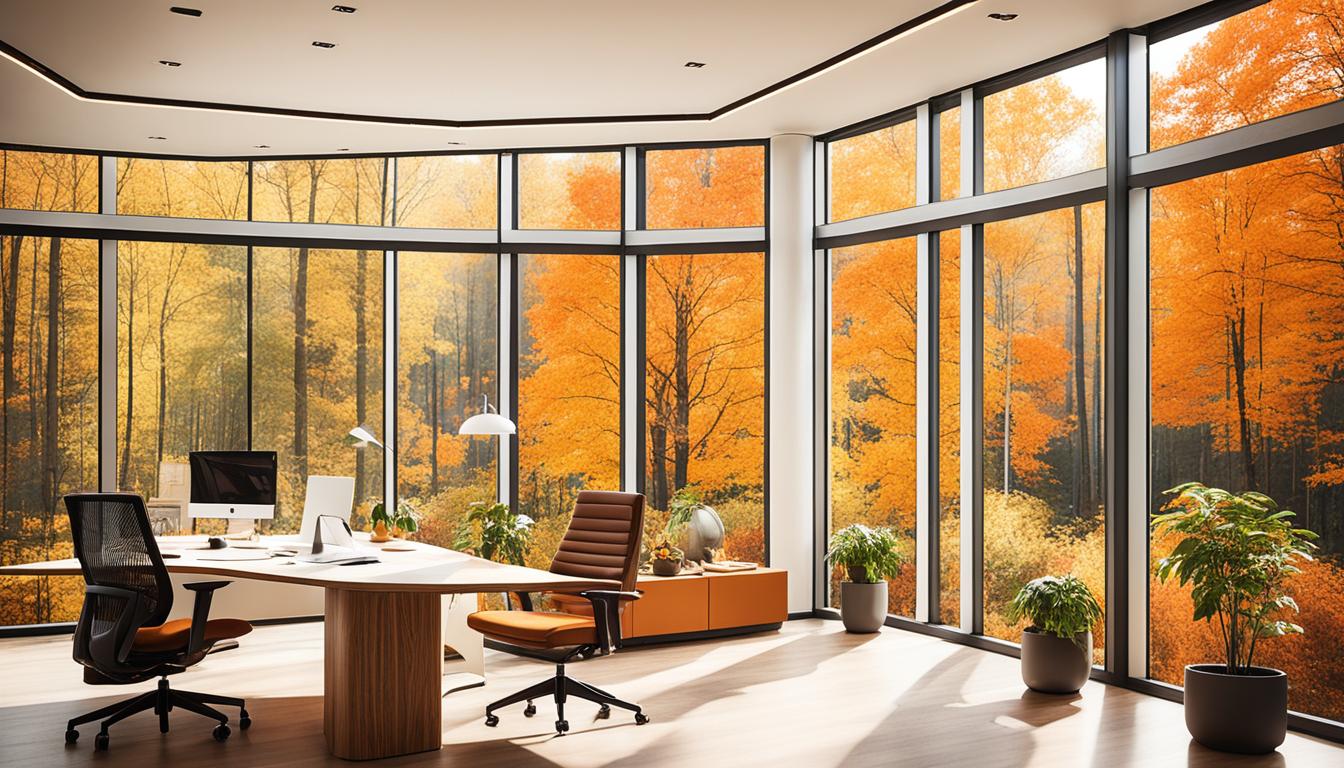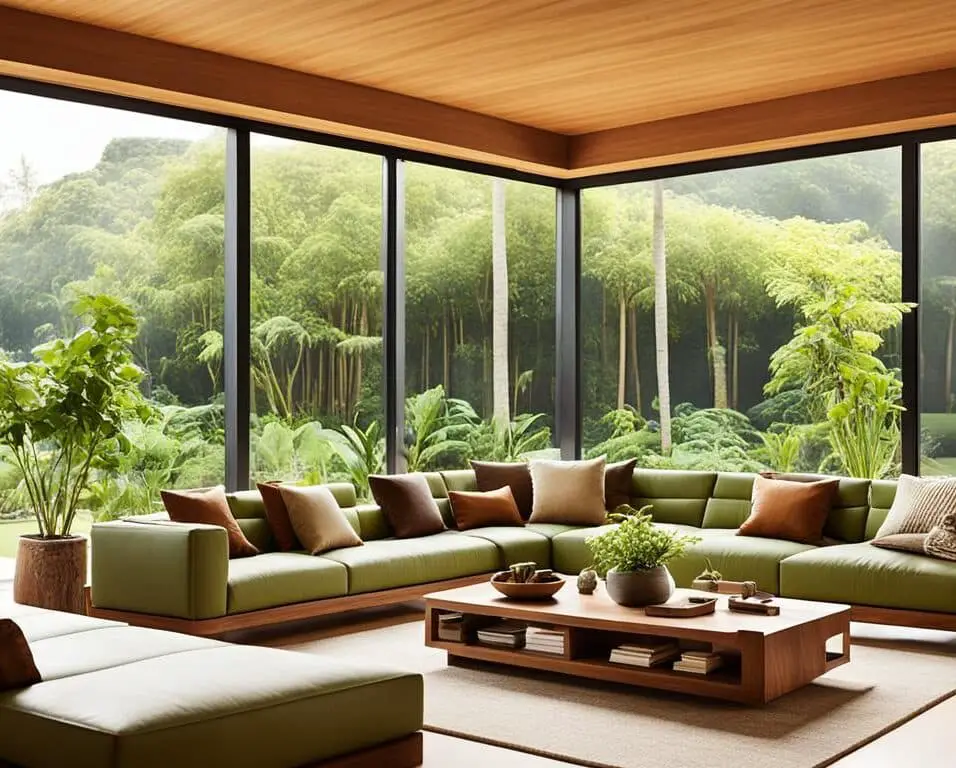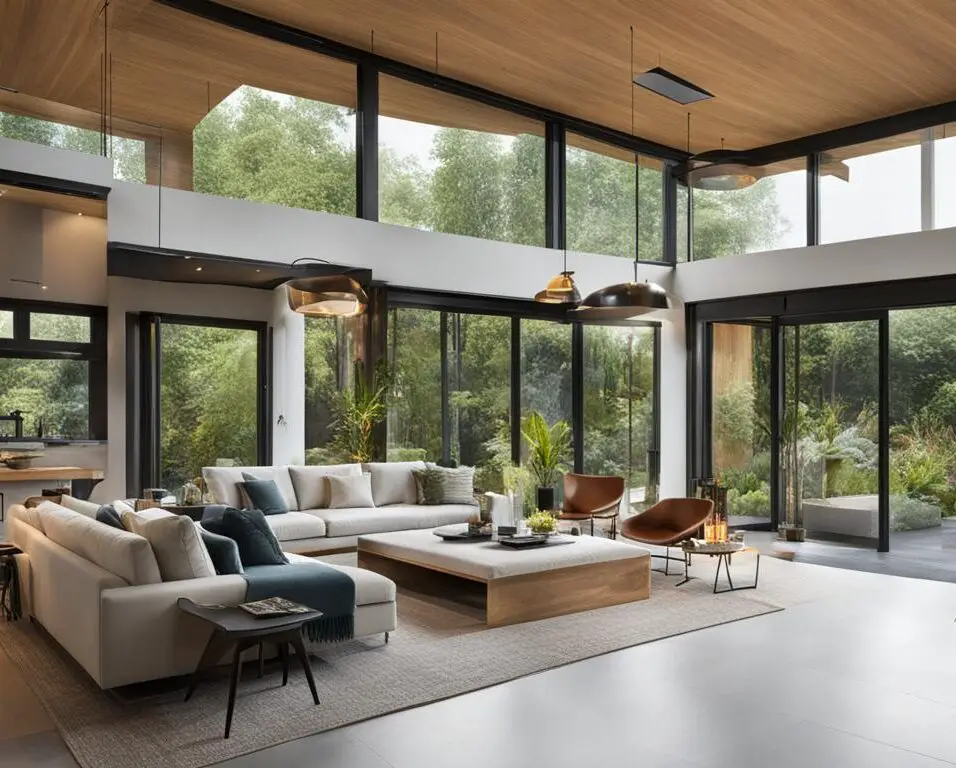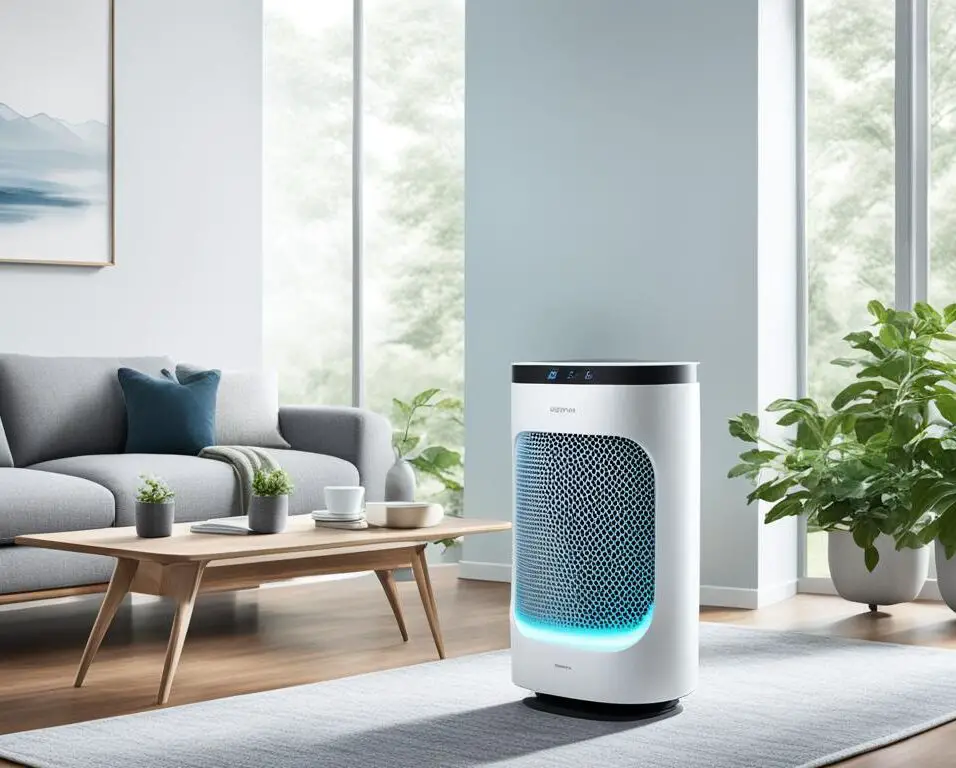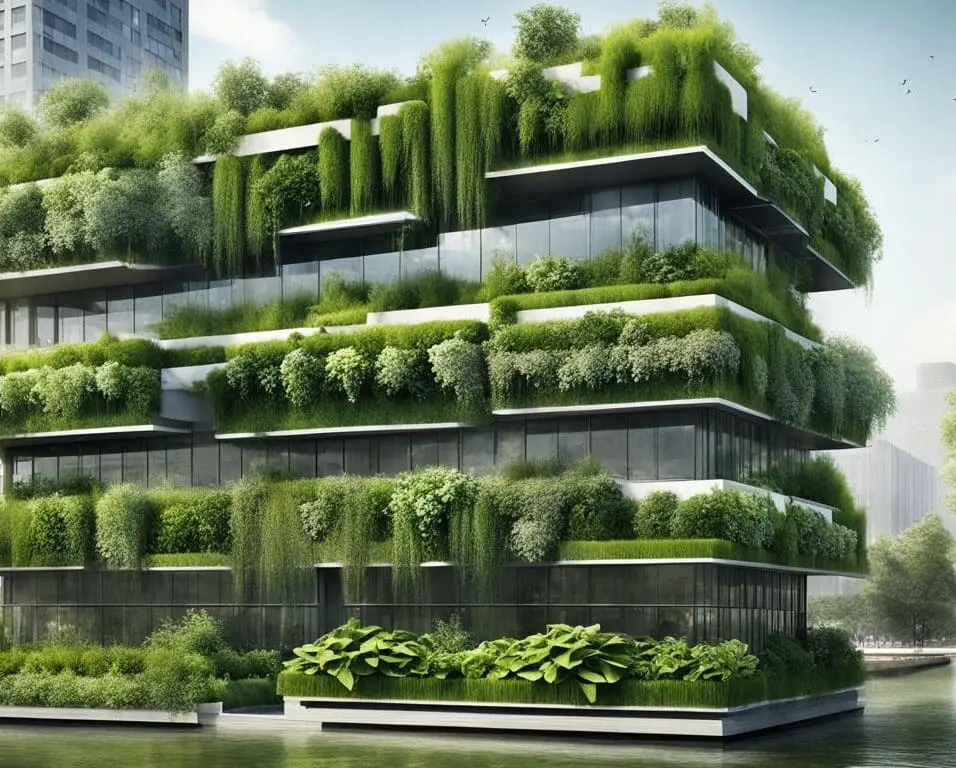Nature’s Remedy: Biophilic Design for Seasonal Affective Disorder
As someone who has personally experienced the impact of Seasonal Affective Disorder (SAD), I understand the importance of finding effective solutions to boost mood and well-being during the darker months. One nature-inspired approach that has shown great promise is biophilic design. By integrating elements of nature into our living and working spaces, biophilic design offers a holistic approach to managing SAD and enhancing our overall quality of life.
Biophilic design encompasses the use of natural light, plants, and natural materials to create spaces that mimic and connect us with the outdoors. This design philosophy recognizes the inherent human need for a connection with nature and leverages it to enhance our well-being. By bringing the essence of the natural world indoors, biophilic design helps to combat the negative effects of SAD and create environments that promote happiness, productivity, and overall wellness.
With its focus on creating a harmonious relationship between humans and their surroundings, biophilic design offers a range of benefits for individuals struggling with SAD. It helps to bring more natural light into our spaces, which can have a positive impact on our mood and energy levels. Additionally, the presence of plants and natural materials provides a sense of tranquility and connection to nature, further boosting our mental and emotional well-being.
Key Takeaways:
- Biophilic design integrates elements of nature into living and working spaces to enhance well-being.
- Natural light, plants, and natural materials are key components of biophilic design.
- Biophilic design can help combat the negative effects of Seasonal Affective Disorder (SAD).
- By mimicking the outdoors, biophilic design creates environments that boost mood and overall happiness.
- Spaces designed with biophilic principles have been shown to improve productivity and employee satisfaction.
The Impact of Light on Happiness and Well-being
Sunlight plays a crucial role in elevating mood and promoting well-being. Exposure to natural sunlight triggers the release of serotonin, a hormone associated with mood elevation. Sunlight also regulates our sleep-wake cycles and is essential for Vitamin D synthesis, which is linked to a reduced risk of depression.
Artificial lighting can also mimic the effects of natural sunlight and be used to create desired moods and atmospheres. By carefully selecting lighting options, we can harness the power of light to enhance our daily lives.
| Natural Sunlight | Artificial Lighting |
|---|---|
| Triggers the release of serotonin | Can mimic the effects of natural sunlight |
| Regulates sleep-wake cycles | Allows for customization to create desired moods |
| Essential for Vitamin D synthesis | Provides consistent illumination regardless of weather conditions |
Natural sunlight offers a multitude of benefits that contribute to our happiness and well-being. However, artificial lighting can be used as an alternative in environments where natural light is limited. Whether it’s embracing the sun’s radiance or harnessing artificial lights that mimic its effects, light plays a vital role in ensuring our overall health and happiness.
The Power of Light Therapy for Mental Health
Light therapy, a non-invasive treatment that involves exposure to specific wavelengths of light, has proven to be highly effective in addressing Seasonal Affective Disorder (SAD) and other forms of depression. By simulating the effects of natural sunlight, light therapy helps reset the body’s internal clock and improves the overall mood. It has also shown promising results in treating sleep disorders and certain conditions like dementia, making it a versatile option for enhancing mental health.
Light therapy works by utilizing specific wavelengths of light that mimic the beneficial effects of sunlight. This type of therapy primarily targets the regulation of the body’s circadian rhythm, which can become disrupted due to reduced exposure to natural light during the winter months. By exposing individuals to bright light, typically in the morning, light therapy helps stimulate the production of serotonin, a neurotransmitter associated with mood regulation.
In addition to its impact on mood, light therapy has been found to have positive effects on sleep patterns. By assisting in the regulation of the sleep-wake cycle, light therapy can help individuals establish more regular sleep patterns, improving overall sleep quality and reducing the symptoms of insomnia.
Moreover, light therapy offers a non-invasive alternative to traditional treatment options for depression and SAD. Unlike medication, light therapy does not require the ingestion of substances and thus avoids potential side effects commonly associated with pharmacological treatments. This makes light therapy particularly attractive for individuals seeking a drug-free approach to managing their mental health.
An important aspect to note is that light therapy should be administered under the guidance of a healthcare professional, as incorrect usage or excessive exposure to light can have adverse effects. Consulting a healthcare provider will ensure the therapy is tailored to individual needs and that the correct light intensity and duration are applied.
Light therapy offers a safe, non-invasive, and drug-free treatment option for Seasonal Affective Disorder and other forms of depression. Its ability to simulate the effects of natural sunlight and regulate the body’s internal clock makes it a powerful tool for improving mental health.
Benefits of Light Therapy:
- Reduces symptoms of Seasonal Affective Disorder (SAD)
- Improves mood and overall well-being
- Regulates sleep-wake cycles and improves sleep patterns
- Treats sleep disorders such as insomnia
- Non-invasive and drug-free treatment option
While light therapy offers significant benefits, it is essential to evaluate its suitability for each individual and seek professional guidance to ensure safe and effective treatment.
| Conditions Treated | Benefits |
|---|---|
| Seasonal Affective Disorder (SAD) | Reduces symptoms, improves mood |
| Depression | Enhances overall well-being |
| Insomnia | Regulates sleep patterns |
| Sleep Disorders | Improves sleep quality |
| Dementia | Assists cognitive function and sleep |
The Concept of Biophilic Design in Enhancing Well-being
Biophilic design seeks to create spaces that connect people with the natural world. By incorporating elements such as natural light, plants, and natural materials, biophilic design creates environments that are aesthetically pleasing and psychologically beneficial. It maximizes natural light penetration, reduces reliance on artificial lighting, and creates spaces that are more in sync with our natural rhythms.
Studies have shown that workspaces with ample natural light have higher levels of productivity and employee satisfaction. When we are exposed to natural light, our bodies respond by regulating our circadian rhythm, enhancing our mood, and improving our overall well-being.
The Benefits of Natural Light in Biophilic Design
Natural light has numerous psychological benefits and is an essential aspect of biophilic design. It not only enhances the aesthetics of a space but also has a positive impact on our mental and emotional well-being.
“Natural light has a profound influence on our mood and productivity. It creates a sense of connection with the outside world and promotes a feeling of openness and vitality.”
Furthermore, exposure to natural light stimulates the production of serotonin, a neurotransmitter that promotes feelings of happiness and overall well-being. It also helps regulate our sleep-wake cycle and promotes better quality sleep.
In addition, natural light provides a more visually comfortable environment, reducing eyestrain and fatigue. It creates a sense of harmony and connection to the natural world, enhancing our overall sense of calm and relaxation.
By incorporating strategies that maximize natural light, such as using large windows, skylights, and light-reflecting surfaces, biophilic design enables us to fully enjoy the psychological benefits of natural light.
Embracing the concept of biophilic design and prioritizing the integration of natural light into our living and working spaces can have a significant positive impact on our overall well-being. By connecting us to the natural world, biophilic design promotes a sense of calm, enhances productivity, and nurtures our psychological health.
Strategies for Implementing Biophilic Design at Home
Implementing biophilic design principles in your home can transform your living spaces into havens of nature-inspired tranquility. By maximizing natural light, utilizing artificial lighting solutions, incorporating color therapy, and incorporating various biophilic design elements, you can create a harmonious and rejuvenating environment that promotes well-being and connection with nature.
Maximizing Natural Light
One of the core principles of biophilic design is maximizing natural light within your living spaces. Natural sunlight not only brightens the rooms but also offers multiple health benefits, including improved mood and increased productivity.
To maximize natural light:
- Arrange your furniture and living spaces to maximize exposure to daylight. Place seating and work areas near windows or in well-lit areas of your home.
- Remove heavy curtains or shades that block sunlight. Opt for sheer curtains or blinds that allow natural light to filter through.
- Use light-colored or reflective surfaces like mirrors and glossy finishes to bounce sunlight throughout the room.
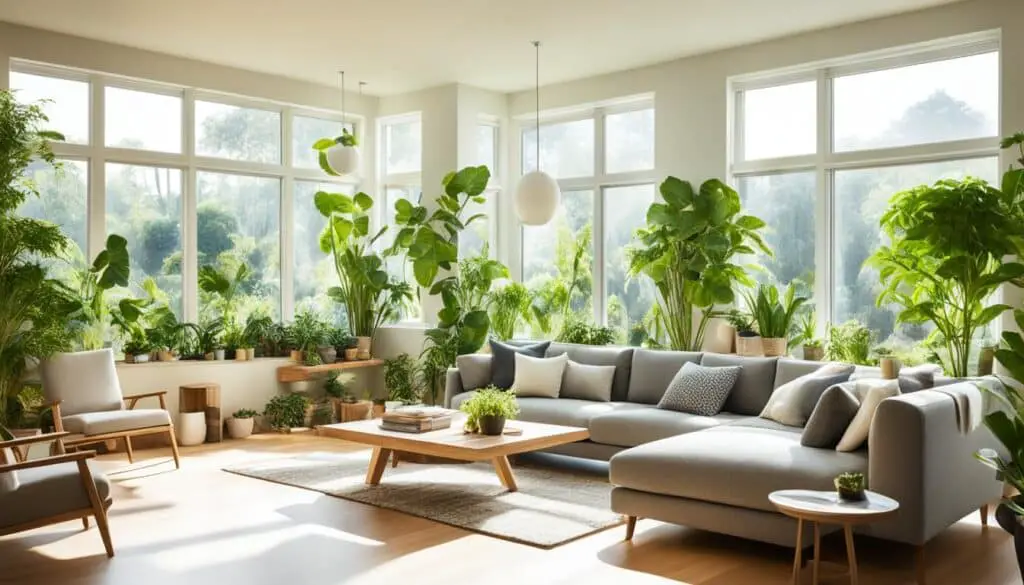
Artificial Lighting Solutions
In addition to natural light, artificial lighting plays a crucial role in creating the desired ambiance and fulfilling the lighting needs of various spaces within your home. By carefully selecting appropriate artificial lighting solutions, you can enhance the biophilic experience and mood in each room.
Consider the following tips:
- Choose full-spectrum light bulbs that mimic natural sunlight as closely as possible.
- Use dimmers to adjust the intensity of artificial lights and create different moods throughout the day.
- Incorporate task lighting in work areas to provide focused and efficient lighting.
- Opt for warm-toned LEDs rather than cool-toned ones for a cozy and inviting atmosphere.
Color Therapy
Color plays a significant role in evoking emotions and setting the desired mood within your living spaces. By incorporating colors that evoke warmth and happiness, you can create a harmonious and uplifting environment.
Consider the following color therapy tips:
- Use bright yellows, soothing greens, or calming blues on walls, furniture, or decor to evoke specific emotions and enhance well-being.
- Create focal points with vibrant or contrasting colors to add visual interest and energy to the room.
- Experiment with different color combinations to find the perfect balance that resonates with your personal preferences and desired atmosphere.
Incorporating Biophilic Design Elements
Bringing elements of nature indoors can have a profound impact on our well-being. Incorporating biophilic design elements seamlessly integrates nature into your living spaces, creating a sense of connection and serenity.
Consider the following biophilic design elements:
- Introduce indoor plants to purify the air, add visual appeal, and bring a touch of nature indoors.
- Use natural textures such as wood, stone, or bamboo in your furniture, flooring, or decor to create a tactile connection with nature.
- Hang photographs or paintings of landscapes, seascapes, or lush greenery to evoke a sense of calm and tranquility.
Creating a Cozy and Comfortable Atmosphere
Lastly, creating a cozy and comfortable atmosphere is vital for enhancing the overall biophilic design experience in your home. By incorporating soft textiles, plush rugs, and comfortable seating areas, you can create inviting and nurturing spaces.
Consider the following tips:
- Add soft blankets and cushions to sofas and chairs to create an inviting and cozy ambiance.
- Place plush rugs or carpets in common areas to add warmth and comfort underfoot.
- Create comfortable seating areas with oversized chairs or loungers where you can relax and immerse yourself in the beauty of your home.
By implementing these strategies and incorporating biophilic design principles, you can transform your home into a sanctuary that maximizes natural light, utilizes artificial lighting solutions, embraces color therapy, and connects you with the soothing elements of nature.
Creating a Supportive Home Atmosphere for SAD
Dedicate a space in your home for relaxation and mindfulness practices, such as meditation or yoga. Creating a designated area allows you to fully immerse yourself in these activities, promoting a sense of calm and tranquility. Whether it’s a corner of your bedroom, a serene nook in the living room, or a dedicated meditation room, having a designated space for relaxation can make a significant difference in managing the symptoms of Seasonal Affective Disorder (SAD).
Consider the following design principles when creating your relaxation and mindfulness space:
- Comfortable Seating: Arrange comfortable seating options like plush cushions or a cozy armchair to provide a relaxing and inviting atmosphere for your meditation or mindfulness practice.
- Soothing Colors and Lighting: Choose calming colors like blues, greens, or earth tones for the walls and decor. Consider incorporating natural materials and elements, such as bamboo or wood, to create a sense of connection to nature. Install soft, warm lighting fixtures to create a soothing and relaxing ambiance.
- Natural Elements: Introduce natural elements like indoor plants or a tabletop fountain to bring a touch of nature into your space. These elements can help create a sense of serenity and provide a visual connection to the outdoors.
- Minimal Distractions: Keep the space clutter-free and free from distractions. Consider using storage solutions like baskets or shelves to keep your meditation area organized and tidy.
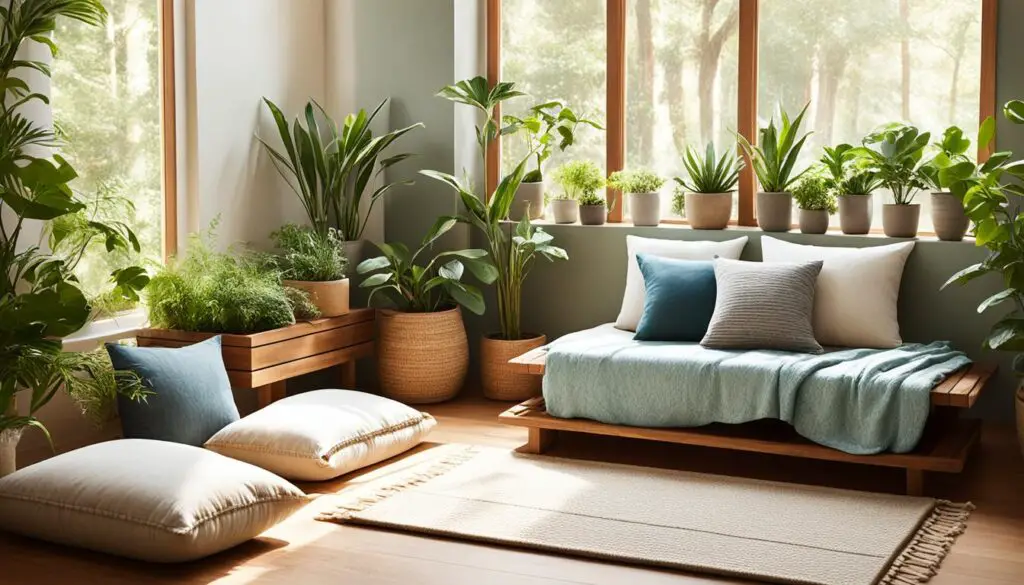
In addition to creating a relaxation and mindfulness space, it’s important to incorporate physical activity into your home environment to combat the effects of SAD. Staying active can help boost your mood and increase energy levels.
Consider the following ideas for incorporating physical activity into your home:
- Home Gym: Dedicate a specific area in your home for exercise equipment or workout routines. Set up a small home gym with basic equipment like weights, resistance bands, or a yoga mat.
- Dance or Yoga Studio: Transform an unused room or corner into a dance or yoga studio. Create a peaceful and energizing space for practicing your favorite exercise routines.
- Outdoor Workout Area: If you have outdoor space available, consider setting up a dedicated area for outdoor exercises like running, stretching, or yoga. Enjoy the fresh air and natural surroundings while staying active.
Remember to embrace design psychology principles throughout your home to create a supportive atmosphere that promotes well-being. Design psychology is the study of how the design of our environment affects our emotions and behavior.
“Design psychology principles can help create a home environment that supports our mental and emotional well-being. By consciously designing our living spaces, we can positively influence our mood, productivity, and overall satisfaction with our home.”
Consider the following design psychology techniques:
- Use Color Psychology: Choose colors that evoke positive emotions and well-being. For example, utilize calming blues or uplifting yellows in your bedroom or living spaces to enhance relaxation and mood.
- Optimize Natural Light: Maximize natural light by keeping windows unobstructed and choosing light-filtering window treatments. Natural light can boost mood and has been linked to increased productivity and overall well-being.
- Arrange Furniture for Flow: Arrange furniture in a way that promotes easy movement and flow through your home. Avoid cluttered and cramped spaces, as they can negatively impact mood and create feelings of stress.
The Benefits of Creating a Supportive Home Atmosphere
| Benefit | Description |
|---|---|
| Stress Reduction | A supportive home atmosphere can help reduce stress levels and promote relaxation, creating a peaceful and calming environment. |
| Mood Enhancement | By incorporating relaxation and mindfulness spaces and staying active, you can improve your mood and increase feelings of happiness and well-being. |
| Improved Mental Health | A supportive home atmosphere contributes to improved mental health by providing a sanctuary for self-care, reducing symptoms of SAD. |
| Increased Productivity | Design psychology principles, such as optimizing natural light and arranging furniture for flow, can enhance productivity and focus in your home environment. |
Creating a supportive home atmosphere that includes relaxation and mindfulness spaces, physical activity areas, and design psychology principles can have a profound impact on your well-being. By consciously designing your home environment, you can create a sanctuary that supports your mental health and helps counteract the symptoms of Seasonal Affective Disorder.
The Connection between Nature and Health
Our physical environment, particularly our connection with nature, has a profound impact on our cognitive functionality, psychological health, and physiological well-being. Studies have shown that exposure to nature can enhance cognitive functioning, reduce stress, and improve physical comfort. Incorporating elements of nature into our living spaces can have positive effects on our overall health and well-being.
Research has indicated that spending time in natural environments improves our cognitive performance. Nature has the ability to restore our attention and focus, allowing us to better concentrate and problem-solve. In fact, a study conducted by the University of Michigan found that even brief interactions with nature, such as looking at a picture of a natural setting, can significantly improve cognitive function.
Additionally, incorporating nature into our living spaces can have a positive impact on our psychological health. Regular exposure to natural elements such as plants, water features, and natural light has been shown to reduce stress, anxiety, and depressive symptoms. Nature has a calming effect on the mind, promoting relaxation and emotional well-being.
Physiological well-being is also influenced by our connection with nature. Spending time in green spaces, such as parks or gardens, has been linked to improved physical health outcomes. Research has shown that exposure to natural environments can lower blood pressure, reduce the risk of chronic diseases, and boost the immune system.
By integrating elements of nature into our living spaces, we can create environments that support both our cognitive functionality and psychological health. Incorporating natural light through windows and skylights, incorporating indoor plants and greenery, and using natural materials like wood and stone can all contribute to a more nature-inspired and health-promoting living environment.
“Incorporating elements of nature into our living spaces can have positive effects on our overall health and well-being.”
Creating a connection with nature doesn’t have to be limited to the outdoors. We can bring nature indoors through the use of biophilic design principles. Biophilic design incorporates natural elements, patterns, and materials into our home environments, creating spaces that foster a sense of well-being and connection with nature.
Incorporating natural elements such as indoor plants, water features, and natural textures can contribute to a calming and rejuvenating atmosphere. Additionally, using colors inspired by nature, such as shades of green, blue, and earth tones, can enhance the psychological impact of our living spaces.
By embracing the connection between nature and our health, we can design living spaces that promote cognitive functionality, psychological well-being, and physiological health.
Conclusion
Embracing biophilic design in our homes offers a proactive approach to managing Seasonal Affective Disorder (SAD) and enhancing our well-being. By incorporating elements of nature, maximizing natural light, and creating a supportive home atmosphere, we can counteract the effects of SAD and create a haven of comfort and positivity.
Our home environment plays a crucial role in maintaining our mental health and happiness, particularly during the winter months when SAD is most prevalent. Biophilic design, with its focus on integrating nature into our living spaces, provides a solution that goes beyond traditional treatment options.
Through natural light and connections to the outdoors, biophilic design allows us to bring the healing power of nature into our homes. This creates an environment that promotes relaxation, reduces stress, and supports our overall well-being. By incorporating elements such as plants, natural materials, and nature-inspired colors, our homes become a sanctuary where we can find solace and rejuvenation.
Incorporating biophilic design principles into our homes not only benefits those struggling with SAD but also enhances the well-being of all occupants. The integration of nature in our living spaces has a positive impact on our physical and mental health, improving cognitive functionality and creating a sense of harmony and connection with the natural world. By prioritizing the biophilic design in our homes, we create an environment that nurtures our well-being and allows us to thrive.
FAQ
How can biophilic design help manage Seasonal Affective Disorder?
Biophilic design focuses on integrating nature into living and working environments. By incorporating elements of nature such as natural light, plants, and natural materials, biophilic design can help improve mood and overall well-being, offering a promising solution for managing Seasonal Affective Disorder.
What role does sunlight play in promoting well-being?
Sunlight plays a crucial role in elevating mood and promoting well-being. Exposure to natural sunlight triggers the release of serotonin, a hormone associated with mood elevation. Sunlight also regulates our sleep-wake cycles and is essential for Vitamin D synthesis, which is linked to a reduced risk of depression. Artificial lighting can also mimic the effects of natural sunlight and be used to create desired moods and atmospheres.
How effective is light therapy in treating Seasonal Affective Disorder?
Light therapy, a technique that involves exposure to specific wavelengths of light, has shown remarkable efficacy in treating Seasonal Affective Disorder and other forms of depression. By simulating the effects of sunlight, light therapy helps reset the body’s internal clock and improve mood. It has also been effective in treating sleep disorders and certain conditions like dementia. Light therapy offers a non-invasive, drug-free treatment option for improving mental health.
What is the concept of biophilic design?
Biophilic design seeks to create spaces that connect people with the natural world. By incorporating elements such as natural light, plants, and natural materials, biophilic design creates environments that are aesthetically pleasing and psychologically beneficial. It maximizes natural light penetration, reduces reliance on artificial lighting, and creates spaces that are more in sync with our natural rhythms. Studies have shown that workspaces with ample natural light have higher levels of productivity and employee satisfaction.
What are some strategies for implementing biophilic design at home?
To implement biophilic design at home, you can arrange living spaces to maximize exposure to daylight and use full-spectrum light bulbs. Incorporate colors that evoke warmth and happiness, such as bright yellows, soothing greens, or calming blues. Bring elements of nature indoors through the use of indoor plants, natural textures, and photographs or paintings of landscapes. Create a cozy and comfortable atmosphere with soft blankets, plush rugs, and comfortable seating areas.
How can I create a supportive home atmosphere for Seasonal Affective Disorder?
To create a supportive home atmosphere for Seasonal Affective Disorder, dedicate a space in your home for relaxation and mindfulness practices, such as meditation or yoga. Create an area for physical activity to combat the effects of SAD. Embrace design psychology principles to create a supportive home atmosphere that promotes well-being and counteracts the symptoms of SAD.
What is the connection between nature and health?
Our physical environment, particularly our connection with nature, has a profound impact on our cognitive functionality, psychological health, and physiological well-being. Studies have shown that exposure to nature can enhance cognitive functioning, reduce stress, and improve physical comfort. Incorporating elements of nature into our living spaces can have positive effects on our overall health and well-being.
How can embracing biophilic design enhance well-being?
Embracing biophilic design in our homes offers a proactive approach to managing Seasonal Affective Disorder and enhancing our well-being. By incorporating elements of nature, maximizing natural light, and creating a supportive home atmosphere, we can counteract the effects of SAD and create a haven of comfort and positivity. Our home environment plays a crucial role in maintaining our mental health and happiness, particularly during the winter months.



